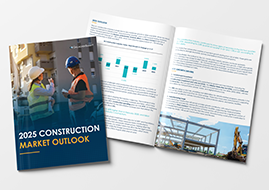
August 30, 2022 — In 1996, the National Safety Council established June, the traditional beginning of summer, as National Safety Month. The purpose is to increase public awareness of the leading safety and health risks prevalent in the summer months in hopes of decreasing the number of injuries and deaths at homes and workplaces.
With the last 26 years in view, it's difficult to comprehend how far we have evolved in terms of technology in a relatively short window of human history. For context, 1996 was the same year Motorola's StarTAC — the first ever flip phone — was released, and Hotmail debuted as the first internet service not tied to an ISP, allowing users to access their inbox from anywhere in the world.
In the realm of commercial safety, technology has advanced considerably, allowing safety and risk professionals to more efficiently aggregate data, analyze trends, and discover insights that can help predict — and hopefully prevent — worker and guest injuries. Supplementing and sometimes replacing existing antiquated data silos and old-school computing infrastructures, cloud-based technologies are incredibly well suited to support modern-day loss control activities. Today's restaurant work functions include many diverse activities. Cloud-based technologies offer us the opportunity to significantly enhance your safety analytics, improve your machine-learning algorithms, and expand application portability across all your restaurant locations.
Typically, risk management duties fall to the finance department of an organization, while safety may report up through operations or human resources. Collaboration is essential to reduce risk regardless of how the reporting structure looks and whether focusing on guest liability or team member safety. When considering how leveraging technology can improve safety programs, it's often most beneficial to focus on areas associated with the most frequent and costly injuries.
Because technologies are constantly evolving, engaging your claims handling entity and current RMIS provider to understand the latest innovations available in the marketplace should be a part of annual planning and strategy conversations. These conversations can provide corrective actions that elevate safety analysis by integrating pre-loss safety investigations and post-loss analysis in support of a modern loss prevention program.
Using the restaurant industry as a use case for analysis, let's review a selection of ways a RMIS solution can provide you with the data-driven insights necessary to enhance risk analysis, improve safety programs, and positively impact the total cost of risk.
Construction Occupancy Protection Exposure (COPE)
Capturing critical COPE characteristics for buildings, fleet, and other assets can be combined with loss history from your claims provider to perform a more holistic assessment of your exposures and respective trends in losses.
Recently, we leveraged our award-winning RMIS solution, Luminos, to build a custom client module that automatically cataloged international property values from locations in more than 90 countries. Resource-intensive processes, long data collection cycle times, and data errors were all impacting their activities and slowing down their renewal timelines.
Working together and within established budgets, our customized online data collection processes include easy-to-use tools that ensure data accuracy and automate survey communications. With client access and analytics to monitor results worldwide, the accompanying data collection cycle timeframe dropped from many months to just a few weeks. Additionally, our client risk management teams estimate that they spend 25% of their allocated hours on data collection.
Root Cause Analysis (RCA) Revisited
Rather than relying solely on claims administrator's data to deliver a RCA, capturing more detailed information and including details around "near misses" can provide clarity on the origin of the losses and underlying issues. Although near misses cause no physical harm or damage to property, they can foreshadow incidents that result in catastrophic loss or injury. They can also represent exceptional opportunities to implement safety hazard remedial actions that can prevent accidents from happening in the first place. In many instances, a RMIS solution may also have the ability to incorporate data from real-time investigations to enrich the analysis.
Using this information, combined with financials from incidents that become claims, a comprehensive view of loss drivers becomes more explicit, allowing you to take more effective preventive measures. Finally, applying lessons learned from analysis — to systematically prevent future issues is the essential final step of any RCA. Your RMIS provider should be an active participant in providing targeted recommendations for safety process improvement.
Safety Audits
RMIS systems can also monitor the efficacy of safety audit procedures. Whether you are auditing to address adherence to safety protocols, use of personal protective equipment, or focus on improving unsafe conditions at a location, this information can immediately provide safety alerts and notifications so that issues are addressed before an incident resulting in a loss.
Using mobile device-enabled RMIS data collection tools simplifies real-time safety audit data collection activities to ensure that your risk management efforts are focused on data analysis and program improvements. By combining your safety audit results with incident and loss information from multiple locations, you gain a more robust process for identifying locations that need additional safety training and accident prevention.
Weather Warnings
Are you currently depending on each location to monitor local conditions and prepare for impending inclement weather? RMIS systems can be used to send alerts to specific locations when damaging storms are approaching, and you can enhance existing storm preparation measures. Additionally, severe weather warnings issued by National Oceanic and Atmospheric Administration can be embedded to send out email alerts to affected areas' leaders with a reminder to implement safety measures immediately.
How to Identify the RMIS Solution that Meets Your Needs
With multiple data sources, round-the-clock input flows, and disparate information sets, how do you pull all of your loss control and safety program details together? Do you have the right tools for the job? Do you have to work for your data, or does your data work for you?
If you aren't currently utilizing a RMIS solution or your current solution does not provide the above functionality, it may be in your best interest to explore implementing or upgrading in order to take advantage of the myriad of benefits automation can provide to your business.
The initial questions to answer are the most obvious and necessary to ensure your investment will benefit you now and in the future by helping you make flawless and well-informed risk management decisions. Consider these questions:
- What processes do you hope to automate or simplify through a RMIS solution?
- What types of data are you interested in cataloging and categorizing?
- What insights or key learnings do you need from a RMIS solution?
Beyond the above answers, it's essential to consider the following questions regarding components and outputs when making your decision:
- How intuitive is the solution to use?
- Who will be able to access and at what levels?
- What is the level of data security and backup?
- What is the data import and export functionality?
- What additional functionality will be added in the future?
- What are the costs, including license fees, user fees, and additional module fees?
A great place to start answering these questions is the 2022 RMIS Report. Published by respected insurance industry veterans David Tweedy and Patrick O'Neill, the annual report is an independent review of all the RMIS product offerings available in the bundled marketplace today. The report includes NPS® scores, feature set evaluations, and general comments covering RMIS system options available for use by risk managers, brokers, and insurance carriers.
Stepping outside the boundaries of traditional RMIS claim inquiry and transactional loss reporting, it's important to consider initial and ongoing training availability for your restaurant locations. System customizations can also be necessary when we need to fulfill specific risk management and loss control requirements. Implementation timelines and RMIS tool accessibility round out questions, ensuring that your RMIS computing tools are available when you need them most.
Conclusion
Whether seeking to expand the utilization of an existing RMIS solution or investing in a partnership with a third party that has an in-house RMIS platform, taking the time to identify your needs at the outset will set you up for success in the future. These examples demonstrate how effectively utilizing a RMIS solution and combining claims administrator data can help you better understand your loss exposures to prevent employee injury or damage to your business.
Prevailing risk management requirements demand accessible computing technologies. These include traditional core RMIS feature sets and additional tools that meet the changing needs of your business — ensuring that the selected RMIS products include all of the data inquiry, transaction reporting, and advanced interactive analytics. These products are crucial to successfully manage your restaurant safety programs and, ultimately, your total cost of risk.
Leveraging the knowledge of a third-party administrator, such as Gallagher Bassett, with decades of RMIS expertise, can help ensure you get the best return on investment and utilize data-driven insights to improve your outcomes.
Make Gallagher Bassett your dependable partner
When making the right decision at the right time is critical to minimize risk for your business, count on Gallagher Bassett's extensive experience and global network to deliver.

